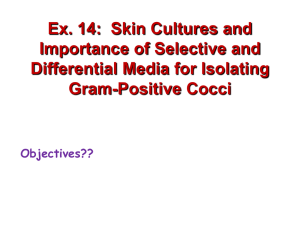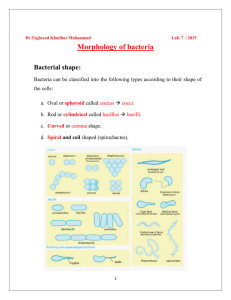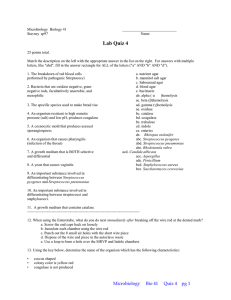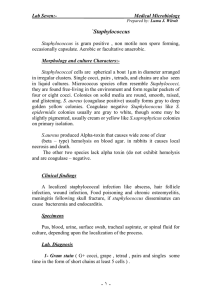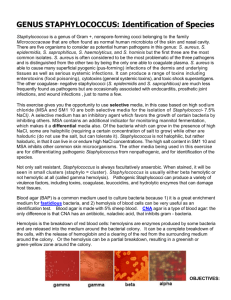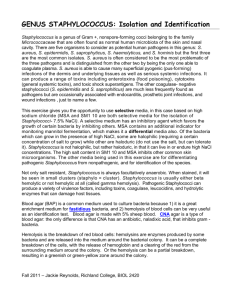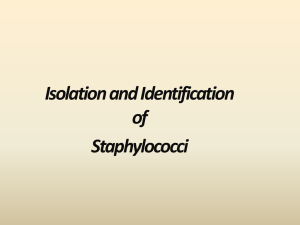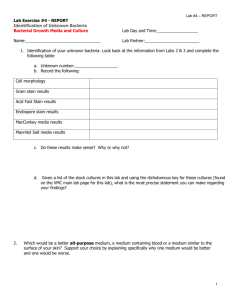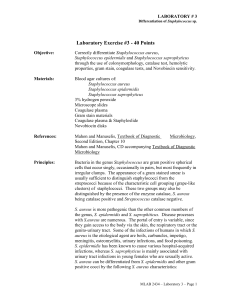Micrococcaceae & Staphylococcus: Lesson Outline
advertisement
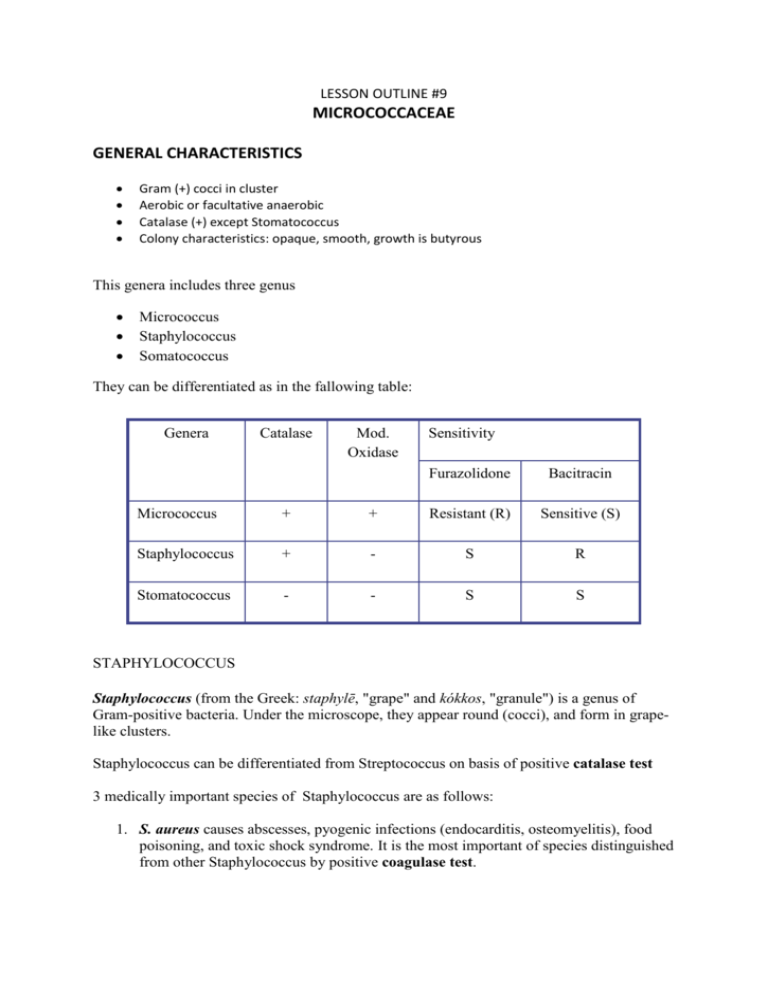
LESSON OUTLINE #9 MICROCOCCACEAE GENERAL CHARACTERISTICS Gram (+) cocci in cluster Aerobic or facultative anaerobic Catalase (+) except Stomatococcus Colony characteristics: opaque, smooth, growth is butyrous This genera includes three genus Micrococcus Staphylococcus Somatococcus They can be differentiated as in the fallowing table: Genera Catalase Mod. Oxidase Sensitivity Furazolidone Bacitracin Micrococcus + + Resistant (R) Sensitive (S) Staphylococcus + - S R Stomatococcus - - S S STAPHYLOCOCCUS Staphylococcus (from the Greek: staphylē, "grape" and kókkos, "granule") is a genus of Gram-positive bacteria. Under the microscope, they appear round (cocci), and form in grapelike clusters. Staphylococcus can be differentiated from Streptococcus on basis of positive catalase test 3 medically important species of Staphylococcus are as follows: 1. S. aureus causes abscesses, pyogenic infections (endocarditis, osteomyelitis), food poisoning, and toxic shock syndrome. It is the most important of species distinguished from other Staphylococcus by positive coagulase test. 2. S. epidermidis may cause endocarditis. It is coagulase negative, produces glycocalyx and sensitive to novobiocin. It is also present on inhabits skin. 3. S. saprophyticus causes urinary tract infections. It is also coagulase negative but resistant to novobiocin. STAPHYLOCOCCUS AUREUS: MICROSCOPY: Gram’s staining CULTURAL CHARECTERS: 1. On Nutrient agar: Opaque, smooth, small, golden yellow colonies. 2. On Sheep Blood agar: Small, opaque, Beta haemolytic colonies. 3. On Tellurite lysine agar: Small, smooth, black colonies. 4. On Mannitol salt agar: ferments mannitol.. Yellow colonies (+) for Staphylococcus aureus) Pathogenecity: It produces many toxins which helps this bacteria to cause disease 1. Enterotoxins –toxin produced that is very potent Laboratory Diagnosis: 1. Microscopy: Gram positive cocci in clusters. 2. Culture: a. On Nutrient Agar Plate (NAP) : Opaque, smooth, small, golden yellow colonies. b. On Sheep Blood Agar Plate (sBAP): Small, opaque, Beta haemolytic colonies. c. On Tellurite lysine agar (TLA) : Small, smooth, black colonies. d. On Mannitol Salt Agar (MSA) : ferments mannitol. 3. Biochemical reactions: a. Catalase Test: Catalase is an enzyme that converts H202 into water and oxygen. Therefore when we put a colony of staphylococcus in H2O2 it gives (+) reaction, that is bubble formation. b. Coagulase Test: In the presence of coagulase, fibrinogen is converted to fibrin. It can be detected by 2 methods. i. Slide test – detects bound coagulase ii. Tube test – detects free coagulase c. DNAse Test: S.aureus also produces DNAse (deoxyribonuclease) which breaks down the DNA. The test agar contains an emulsion of DNA, peptides as a nutrient source, and methyl green dye. Bacterial colonies that secrete DNase will hydrolyze the DNA in the medium, . This results in clearing around the bacterial growth. d. Oxidase Test: Bacteria that possess cytochrome C produce a dark-blue end product when reacted with modified oxidase reagent. 4. Antibiogram: The antibiotics which can be used area. Lysostaphin b. Bacitracin c. Furazolidone d. Novobiocin 5. Serology: Many readymade tests are available to detect staphylococcal infection. 6. Phage Typing SUPPLEMENTAL READING: Microbiology Demystified by Tom Betsy, 2005. Foundation of Microbiology, 4th edition by Talaro, Kathleen , 2002. Chapter 7. Elements of Microbial Nutrients Textbook: Microbiology: introduction 10th edition: Tortora, Funk, case

